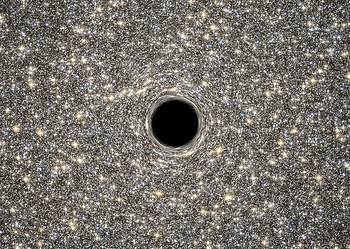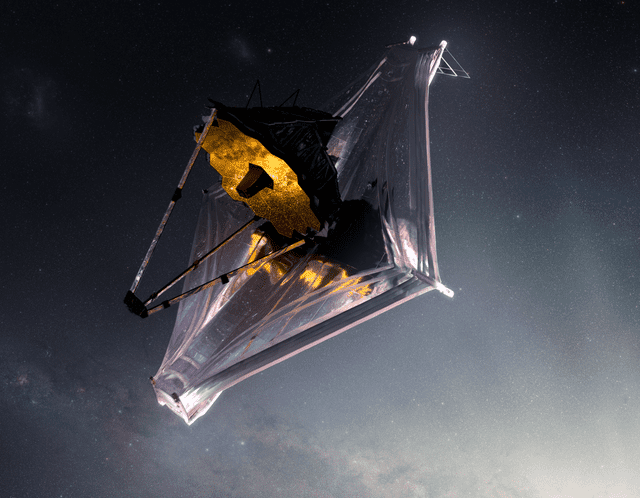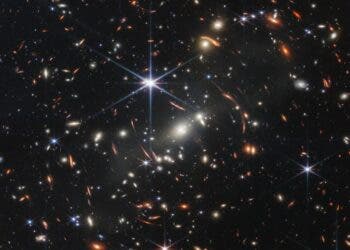Our theories of the Universe have a missing matter problem: half of its matter is missing. But now this ‘missing baryon problem’ one of the most lingering puzzles in cosmology has been solved.
Analysis of the Cosmic Microwave Background (CMB), the radiation left over from an event that occurred shortly after the ‘Big Bang’ which evenly fills the entire Universe, tells physicists that ‘normal’ or baryonic matter — the stuff that forms planets, stars, and our bodies — should account for roughly 5% of the total matter and energy in the Universe.
The problem has been that until now, roughly half of this baryonic matter (essentially the building blocks of everything we see around us ) has been missing.
Australian astronomers have used fast radio bursts, mysterious blasts of radio-wave radiation that occur in random directions through deep space, whose origins are as of yet unknown, to trace this missing matter for the first time. In the process, the discovery helps confirm that both theories of nucleosynthesis in the early Universe, and our concept of how the cosmos developed immediately following the Big Bang are correct.
The team’s findings are published in the journal Nature.

“The matter in this study is ‘ordinary’ matter — the material that makes up our bodies, the Earth, and the entirety of the periodic table. We refer to this matter as ‘baryonic’–matter made up of baryons like electron and protons,” says the paper’s co-author Professor J. Xavier Prochaska, UC Santa Cruz, says. The researcher adds that it’s worth noting that this matter isn’t ‘dark matter’ which accounts for roughly 85–90% of the Universe’s matter content.
The two-decade-long hunt for the missing baryonic matter
Thus far astronomers have spent at least two decades searching for this matter using a very precise estimate of the total mass of baryons in our Universe derived from an analysis of data from the early Universe.
“The hunt for missing matter engaged astronomers across the globe over the past 20 years,” Prochaska explains. “An unofficial accounting estimates 1000+ orbits with the Hubble Space Telescope, thousands of hours with the Chandra X-ray Observatory, and 100+ nights on the largest optical telescopes; these total over $50M USD in operations alone.”
Yet, despite this monumental effort, a successful census of all the matter in the Universe has not been carried out — until now. Current best measurements account for only around half the baryonic matter, leaving the other half effectively missing.
“When we looked out into the present Universe, we couldn’t find half of the matter that should be there,” says lead author, Associate Professor Jean-Pierre Macquart, Curtin University, International Centre for Radio Astronomy Research (ICRAR). “It was a bit of an embarrassment.”
The issue with finding this missing matter is primarily because it is extremely diffuse and space is extremely sparse. Macquart compares that searching for this matter to searching for just a few atoms in a room the size of the average office. The problem with this matter existing in such a diffuse and tenous gas is that it doesn’t emit light itself, and when background light passes through it, none is absorbed.
Thus this missing matter doesn’t leave any ‘fingerprint’ and it is, for all practical purposes, invisible. This means that traditional telescopes and the techniques associated with them simply aren’t effective enough to spot such diffuse matter.

“The missing matter has a density and temperature that make it effectively invisible to any other technique used to observe it,” explains Prochaska. “Indeed, we have not imaged it either.”
“In a way, you can think of this as ‘grey matter’ in that, it isn’t dark matter,” Macquart explains. “It’s ordinary matter that we could see if it weren’t so diffuse.”
The team of astronomers, therefore, had to find another way to detect that matter. That means finding some other impact or effect that this matter could have, that could be spotted. This is where the phenomenon of Fast Radio Bursts (FRBs) comes in to play.
Fast Radio Bursts as a detection method
The first Fast Radio Burst was detected in 2007 and since then these, seemingly random blasts of radiation lasting just a few milliseconds, have been recorded many times. This includes the observation in April this year, of the first FRB within our own galaxy, and the first regularly repeating FRB —named FRB 181112 — in 2018.
Yet, the actual origins of these emissions and their causes are still unknown.
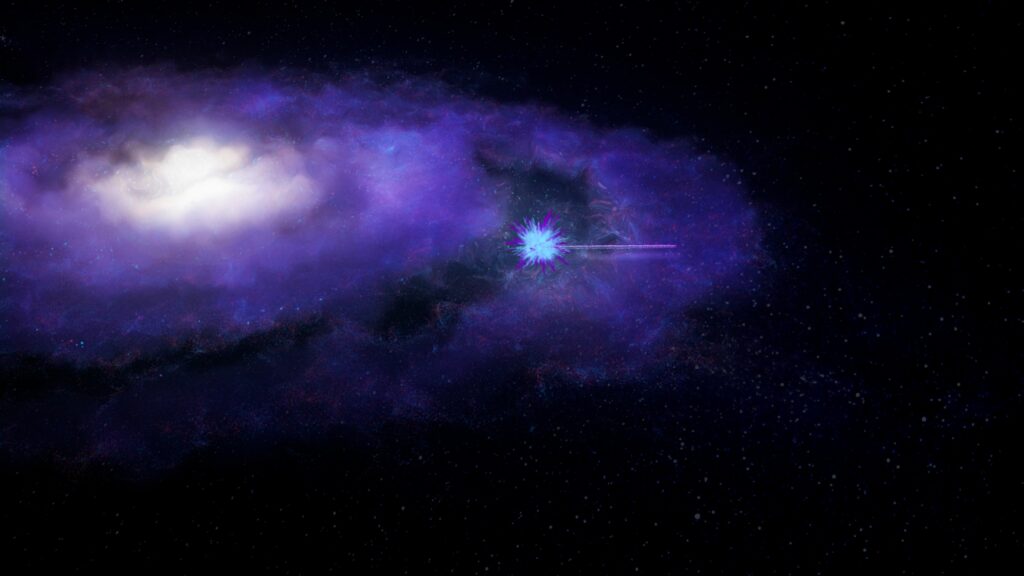
Despite the mystery around their emission, researchers have still found a way to both localize their source to a host galaxy and to utilize FRBs to measure other phenomena in the Universe. Last year, Prochaska himself was part of research to investigate diffuse gas haloes using FRBs as a probe. The researcher says that from their very discovery by Duncan Lorimer and his student David Narkevic thirteen years ago, he believed that FRBs could be employed in the search for missing baryonic matter.
“In 2007, I recall discussing Duncan Lorimer’s paper on the first fast radio burst — sometimes referred to as the ‘Lorimer Burst’ — the morning it published,” Prochaska says. “It hit me right then that this would be the best way to find the missing matter.”
To make the detection the team utilized two distinct methods, the dispersion measure and the redshift of the FRB’s origin galaxy. The dispersion measure allows researchers to count the number of encountered electrons as these slow the propagation of the FRB — with different frequencies that make up the burst be affected to varying degrees.
Whilst, analysis of the spectrum yields the redshift which is effectively a measure of the distance to the FRB’s origin galaxy. This latter part is important because the researchers need to know just how much ‘space’ the FRB has traveled through.
“Thus, combining redshift and dispersion measure, we can assess the total mass in baryons in the universe,” Prochaska explains.
It’s all about timing…
FRBs can be used as a probe for baryonic matter because as they travel across the Universe, every atom they encounter slows them down by a tiny amount. This means that they carry with them a trace of every atom they encounter along their line of travel. Even those astronomers can’t see.
The tenous gas cloud that the FRB passes through consists of atoms that have been ionised, this means that the protons and electrons have been separated and float freely in the gas.
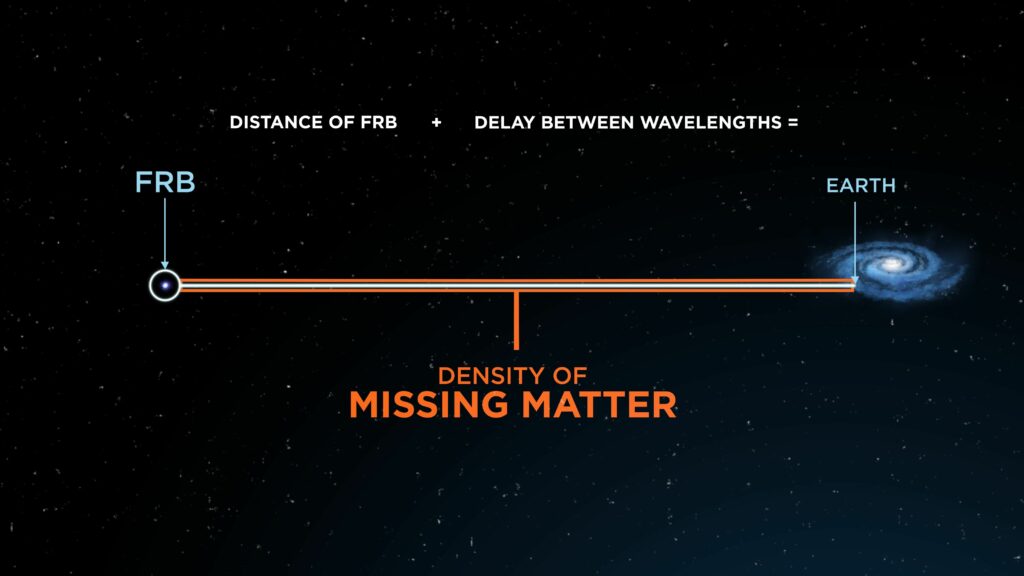
Earth and the delay between the wavelengths of the FRB, (Credit: ICRAR)
When radio waves pass through this ionised gas, the different frequencies that make up the FRB propagate at slightly different speeds. This means that the different frequencies which start off perfectly aligned become slightly spread out bt the time the FRB reaches the other side of the gas cloud.
Macquart describes this phenomenon as exactly what we see when light passes through a prism.
This dispersion in timing is tiny but builds up over the vast distances travelled between galaxies, and the amount of dispersion is exactly proportional to the amount of ionised matter the radio pulse has passed by.

the FRB travel at the same speed, but when travelling through the missing matter, some wavelengths are slowed down. (Credit: ICRAR)
Thus, when the team measure these FRBs they can calculate how smeared out in time the frequencies are, revealing just how much-ionised matter they had passed through on their journey to us. Once the distance of the origin galaxy from which the bursts originated is known, the astronomers could also then measure the average density of the ionised matter, and check this against theoretical predictions.
Leading the way with ASKAP
This combination of methods also required a combination of telescopes and techniques. To conduct their study the team of astronomers turned to CSIRO’s Australian Square Kilometre Array Pathfinder (ASKAP) — a radio telescope consisting of 36 12-inch antennas located roughly 500 miles north of Perth in Western Australia — and some of the world’s most powerful optical telescopes. Prochaska is clear here though: “ASKAP led the way.”
The team used ASKAP to measure the positions of the FRB and thus determine the galaxy from which they originated, unsurprising, as the instrument has become the foremost piece of technology in terms of localising FRBs.

astronomers to calculate the density of the missing matter (Credit: ICRAR and CSIRO/Alex Cherney)
ASKAP found the smeared-out bursts of radio emission, which gave the researchers two key pieces of information — how much ionised matter was between the source of the burst and us on Earth, and where to go looking for the galaxy that the burst had originated in. This is why ASKAP was key to the team, whilst other radio telescopes are able to localise FRBS, almost none of them can pinpoint the location of the burst precisely enough to determine which galaxy they came from.
“To ID an FRB we had to scour through weeks of data to find a single interesting measurement,” Dr Keith Bannister, an Astronomer at CSIRO explains. “Like a needle in a haystack the size of 100 football stadiums.” Fortunately, ASKAP has what Bannister calls a ‘live-action replay’ saving the last 3 billion measurements–just 3 seconds worth of data–from each antenna.
The ASKAP could only solve 2/3 of the missing baryon puzzle, however. Other telescopes were used to measure the redshift of these host galaxies, most incredibly distant and faint, with this measurement giving the team an estimate of the distance and the speed at which the expansion of the Universe is carrying it away. Once the FRB travel distance was known the team could calculate the density of all the atoms along the line of sight.
We know the missing matter is there, now we need to know where ‘there’ is
The idea of ‘finding’ this missing matter may be a touch misleading. The team are quick to point out, that even though they now are able to show that this matter is there, they are yet to determine exactly where it is and how it is distributed.
The next question they will aim to answer is whether this gas is evenly spread smoothly between galaxies, or if it is gathered in haloes and filaments?
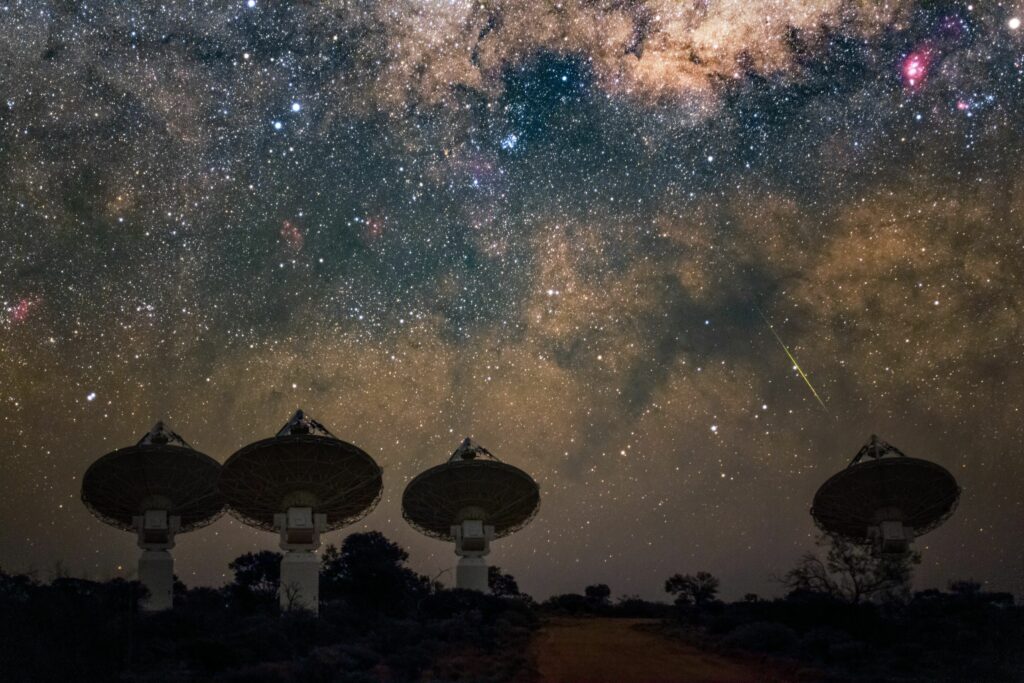
“Of particular interest to astronomers is to ascertain the fraction of the material that is tightly bound to galaxies versus the fraction that is out in the open Universe — what we refer to as the intergalactic medium or cosmic web,” Prochaska says. But, for him in particular, this finding marks the end of a twenty-year journey.
“I began this pursuit in 2000 as a postdoc at Carnegie Observatories,” Prochaska concludes. “Ten years after the discovery of Fast Radio Bursts as new radio experiments were tooling up to join the search, I formed a team called ‘Fast and Fortunate for FRB Follow-up’ ) to perform the follow-up with optical telescopes.
“I never dreamed it would go this smoothly…”
References: Macquart. JP, Prochaska. J. X, McQuinn. M, et al, ‘A census of baryons in the Universe from localized fast radio bursts,’ Nature, [2020].
